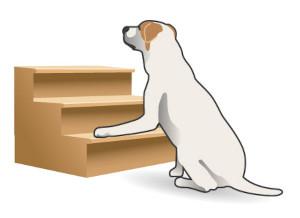
Identifying changes in your dog’s mobility could be challenging. The indications of slowing mobility develop gradually, and you may mistakenly take it as usual signs of aging. Does your dog experience difficulty rising after rest, display less activity, or face challenges climbing stairs? These could be signals that your dog requires assistance with a lifting harness and your support to move around.
Let us explore several common signs that recommend your dog benefit from a lifting harness.
1. Slow in Rising

Image Credits: Walkin’ Pets
One of the initial signs indicating that a dog might benefit from assistance is when an older canine attempts to stand after a lengthy nap. Senior dogs may exhibit sluggishness or struggle to rise unaided. Getting up requires considerable leg strength to push off the ground. Actually, standing up could be a real challenge for dogs who are feeling weakened or joint discomfort.
The impact of a lifting harness
A rear support leash can provide practical aid for your dog’s back legs while they remain rested. By placing a loop over each of the dog’s back limbs and gently sliding them up to the upper part of the legs, the harness allows for a gentle lift. This will assist the dog in standing with all four legs.
2. Struggling with Stair Climbing

Image Credits: Walkin’ Pets
If you carefully watch how your dog climbs the stairs, you can see the change in their mobility. It is the indicator that your dog may need help on the stairs, including:
- Discomfort or unwillingness while using the stairs, displaying uncertainty or avoidance
- Excessive panting or signs of fatigue during stair climbing
- Demonstrating instability or lack of balance
- Inability to regulate descent, leading to rapid movement or difficulty stopping
Your dog may demonstrate additional cues as well. If a dog feels insecure while using the stairs, they might resist climbing up or even refuse to navigate them altogether. This reluctance generally stems from their need for more confidence in safely climbing the stairs.
Descending stairs also gives similar challenges for many older dogs. Some may quicken their pace while dropping, apparently struggling to maintain control. This accelerated descent can lead to significant risks, especially when dogs lack the leg strength to slow down effectively.
The role of a lifting harness
Utilizing a lifting harness can provide considerable assistance: A supportive harness equips you to manage your dog’s movements on the stairs. Such a harness naturally includes handles that facilitate lifting and stabilizing your dog while navigating stairs. This aid is beneficial for both ascending and descending stairs. Look for a harness that offers support for your dog’s front and hind legs to ensure optimal control and assistance during stair navigation.
3. Lagging on the Daily Walk
Observing your dog slowing down or showing symptoms of fatigue during longer walks could signal weakening legs. As dogs age, changes in mobility are natural, and seeking advice from your veterinarian regarding any concerns is recommended. If your dog exhibits reluctance to go for walks or frequently appears fatigued, scheduling a vet visit becomes essential. Overlooking these signs might lead to more severe health issues in the future.
The impact of a lifting harness
Assisting your dog’s hind legs while on a walk significantly eases strain and minimizes the pressure on aching joints. Introducing a rear support harness is beneficial in the initial stages of mobility loss. It also serves as post-exercise support for dogs experiencing shaky or weakened legs after lengthy walks. For dogs requiring additional support or independence, a rear wheelchair could be preferable for extended walks and sustaining an active lifestyle.
4. Intermittent Balance Issues

Image Credits: Walkin’ Pets
Identifying weakening legs in dogs would be challenging for pet owners, as not all signs of weakness are visible consistently. Some dogs might occasionally display swaying in their hind end, stumble, or experience periodic balance loss.
Keep an eye out for these indicators and seek advice from your veterinarian, as they might suggest the need for occasional assistance.
What is the role of a lifting harness?
Utilizing a rear harness to gently lift your dog’s hind end offers additional support, enabling them to stand and walk with reduced risk of losing balance or falling over. This support is beneficial for brief outings, as some dogs encounter balance issues, especially during potty times.
5. Recovery from Injury or Surgery
Dogs with leg injuries often favor the injured limb. This leads to increased strain on the healthy limb, potentially impacting the dog’s overall health. This uneven weight distribution can impose unnecessary pressure on the unaffected limb. As a result, it will begin potential issues.
How does a lifting harness can help a doggy?
Using a harness for support when a dog is injured helps them stand comfortably while evenly distributing their weight. This preventive measure eases excessive strain on the unaffected limb, minimizing the risk of further injury. However, consulting a veterinarian before using a harness is essential. This kind of support will balance the dog’s healing process without causing harm. It is necessary to use a harness only based on the vet’s recommendation and after receiving clearance.
